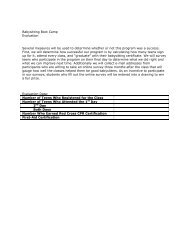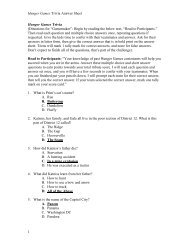Causes of Eutrophication and its Effects of on Aquatic Ecosystems
Causes of Eutrophication and its Effects of on Aquatic Ecosystems
Causes of Eutrophication and its Effects of on Aquatic Ecosystems
Create successful ePaper yourself
Turn your PDF publications into a flip-book with our unique Google optimized e-Paper software.
saturated oxygen caused by the death <str<strong>on</strong>g>and</str<strong>on</strong>g> decompositi<strong>on</strong> <str<strong>on</strong>g>of</str<strong>on</strong>g> plants, subsequent fish kills, <str<strong>on</strong>g>and</str<strong>on</strong>g> loss<str<strong>on</strong>g>of</str<strong>on</strong>g> aquatic biodiversity. Additi<strong>on</strong>ally, blooms <str<strong>on</strong>g>of</str<strong>on</strong>g> algae known as red or brown tides carry toxinsthat are absorbed into animal tissues, such as shellfish, <str<strong>on</strong>g>and</str<strong>on</strong>g> may harm humans if ingested.Cyanobacteria also release neurotoxins that pois<strong>on</strong> livestock <str<strong>on</strong>g>and</str<strong>on</strong>g> threaten humans (Carpenter et.al., 1998). The process <str<strong>on</strong>g>of</str<strong>on</strong>g> reversing eutophicati<strong>on</strong> is difficult due to the challenges in trackingpolluti<strong>on</strong> to <str<strong>on</strong>g>its</str<strong>on</strong>g> sources as well as the magnitude <str<strong>on</strong>g>of</str<strong>on</strong>g> the affected areas. However, thoughphosphorus has no documented negative effects <strong>on</strong> humans or animals, nitrate polluti<strong>on</strong> is toxicat high c<strong>on</strong>centrati<strong>on</strong>s, <str<strong>on</strong>g>and</str<strong>on</strong>g> can harm infants as well as cattle if levels reach 45 mg/L (Carpenteret. al., 1998). Because <str<strong>on</strong>g>of</str<strong>on</strong>g> this <str<strong>on</strong>g>and</str<strong>on</strong>g> other negative effects associated with eutrophicati<strong>on</strong>,numerous papers exist c<strong>on</strong>cerning the assessment <str<strong>on</strong>g>and</str<strong>on</strong>g> management <str<strong>on</strong>g>of</str<strong>on</strong>g> eutrophic aquaticecosystems. One such paper describes rating eutrophic levels based <strong>on</strong> c<strong>on</strong>centrati<strong>on</strong>s <str<strong>on</strong>g>of</str<strong>on</strong>g> nitrate,as nitrogen is the most limiting nutrient for phytoplankt<strong>on</strong> growth (Stefanous et. al., 2000).In this study we observed the process <str<strong>on</strong>g>of</str<strong>on</strong>g> eutrophicati<strong>on</strong> in a system <str<strong>on</strong>g>of</str<strong>on</strong>g> aquariums bytreating the submerged macrophyte <str<strong>on</strong>g>of</str<strong>on</strong>g> a species <str<strong>on</strong>g>of</str<strong>on</strong>g> Elodea that is comm<strong>on</strong> to temperate low-l<str<strong>on</strong>g>and</str<strong>on</strong>g>streams <str<strong>on</strong>g>and</str<strong>on</strong>g> lakes, with fertilizer run-<str<strong>on</strong>g>of</str<strong>on</strong>g>f applied to potted corn plants (Madsen <str<strong>on</strong>g>and</str<strong>on</strong>g> Baattrup-Pedersen, 1995). Our group c<strong>on</strong>ducted this experiment in order to better underst<str<strong>on</strong>g>and</str<strong>on</strong>g> the effects <str<strong>on</strong>g>of</str<strong>on</strong>g>fertilizer input <str<strong>on</strong>g>and</str<strong>on</strong>g> eutrophicati<strong>on</strong> <strong>on</strong> aquatic systems. We hypothesized that eutrophicati<strong>on</strong>would occur in tanks treated with fertilizer <str<strong>on</strong>g>and</str<strong>on</strong>g> that no significant evidence <str<strong>on</strong>g>of</str<strong>on</strong>g> eutrophicati<strong>on</strong>would occur in our c<strong>on</strong>trol tanks. Based <strong>on</strong> our hypothesis we predicted that inputs <str<strong>on</strong>g>of</str<strong>on</strong>g> fertilizershould increase the growth <str<strong>on</strong>g>of</str<strong>on</strong>g> the Elodea plants in our experimental tanks, while the plants in ourc<strong>on</strong>trol tanks should have a significantly lower increase in growth. Additi<strong>on</strong>ally we predictedthat nitrogen, phosphorus, <str<strong>on</strong>g>and</str<strong>on</strong>g> amm<strong>on</strong>ia c<strong>on</strong>centrati<strong>on</strong>s as well as optical density <str<strong>on</strong>g>of</str<strong>on</strong>g> treated tanks2






